Critical Analysis: Barrier Nursing and NHS Outcome Framework Impact
VerifiedAdded on 2023/01/12
|9
|2483
|32
Report
AI Summary
This report provides a comprehensive analysis of barrier nursing, emphasizing its critical role in infection control within the National Health Service (NHS) framework. It examines the rationale behind barrier nursing, its impact on patient outcomes, and the different forms of evidence that inform the discipline. The report delves into the practical application of barrier nursing, including the use of personal protective equipment (PPE) and the importance of patient isolation. It also reflects on the strengths and development needs of healthcare practitioners in this context, highlighting the contributions of evidence-based practice to their professional development. Furthermore, the report addresses the benefits and challenges of barrier nursing, such as the potential for patient anxiety and the need for effective communication. The conclusion reinforces the significance of barrier nursing in preventing the spread of infectious diseases, particularly in light of recent global health challenges like COVID-19, and its importance for the professional development of healthcare practitioners.
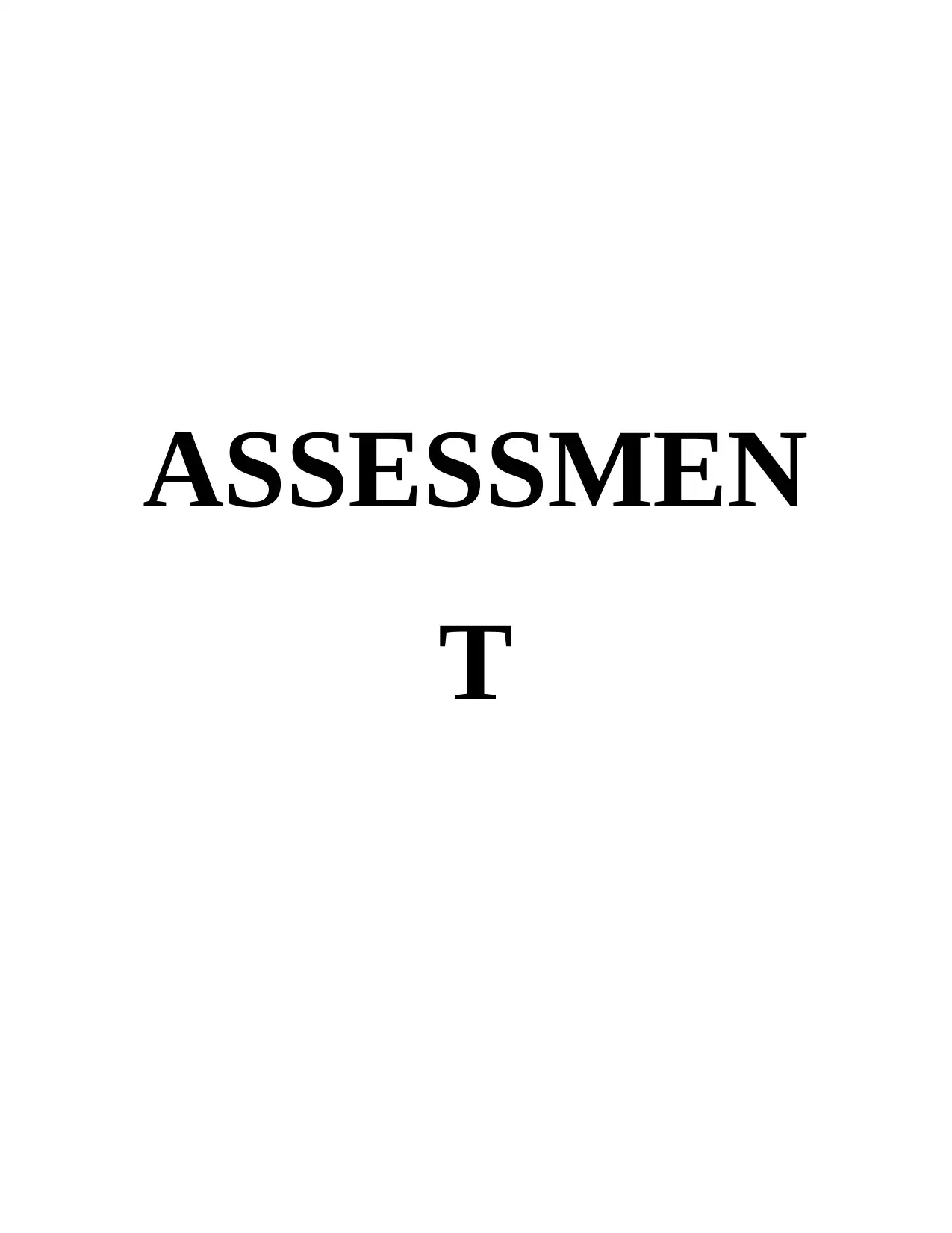
ASSESSMEN
T
T
Paraphrase This Document
Need a fresh take? Get an instant paraphrase of this document with our AI Paraphraser
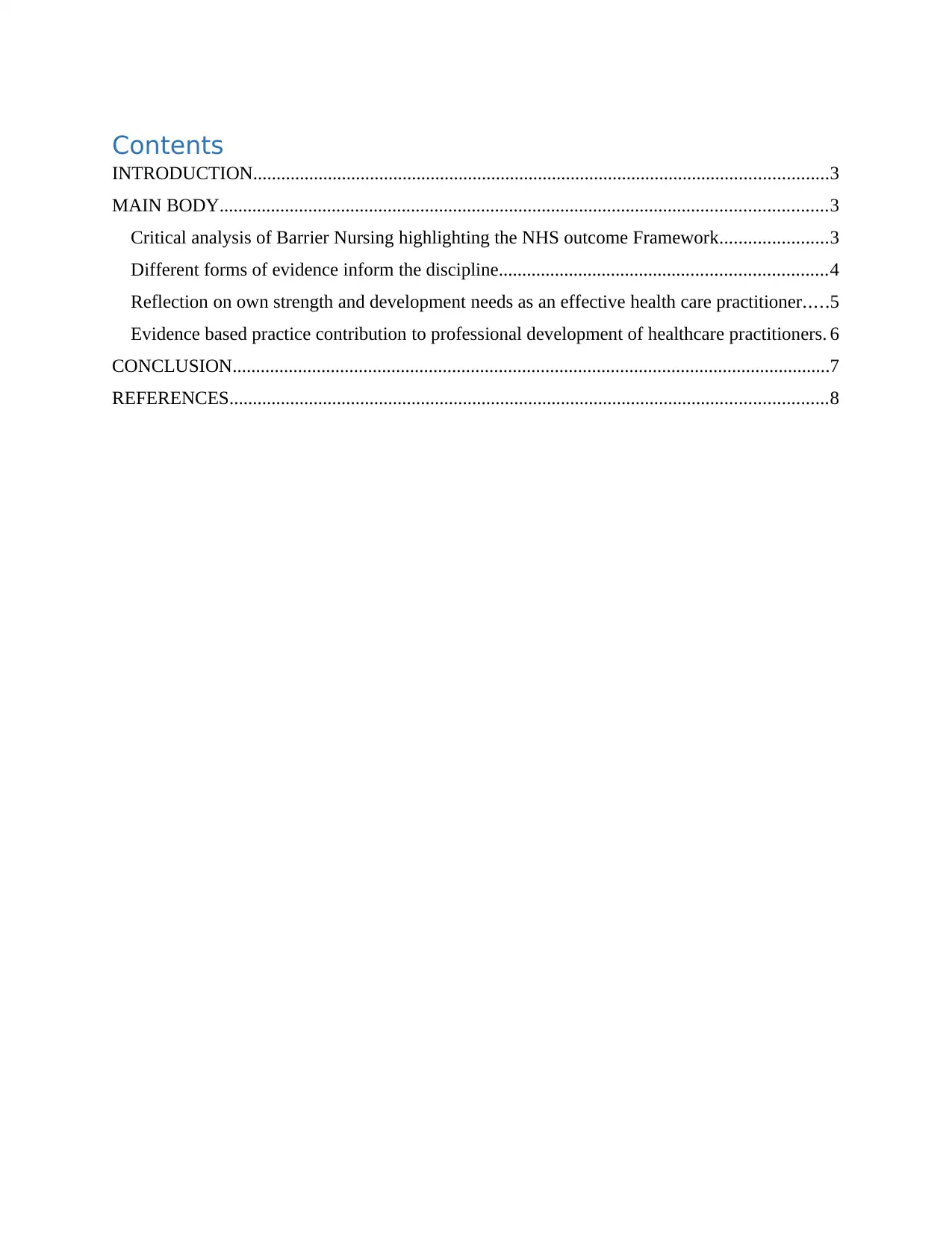
Contents
INTRODUCTION...........................................................................................................................3
MAIN BODY..................................................................................................................................3
Critical analysis of Barrier Nursing highlighting the NHS outcome Framework.......................3
Different forms of evidence inform the discipline......................................................................4
Reflection on own strength and development needs as an effective health care practitioner.....5
Evidence based practice contribution to professional development of healthcare practitioners. 6
CONCLUSION................................................................................................................................7
REFERENCES................................................................................................................................8
INTRODUCTION...........................................................................................................................3
MAIN BODY..................................................................................................................................3
Critical analysis of Barrier Nursing highlighting the NHS outcome Framework.......................3
Different forms of evidence inform the discipline......................................................................4
Reflection on own strength and development needs as an effective health care practitioner.....5
Evidence based practice contribution to professional development of healthcare practitioners. 6
CONCLUSION................................................................................................................................7
REFERENCES................................................................................................................................8
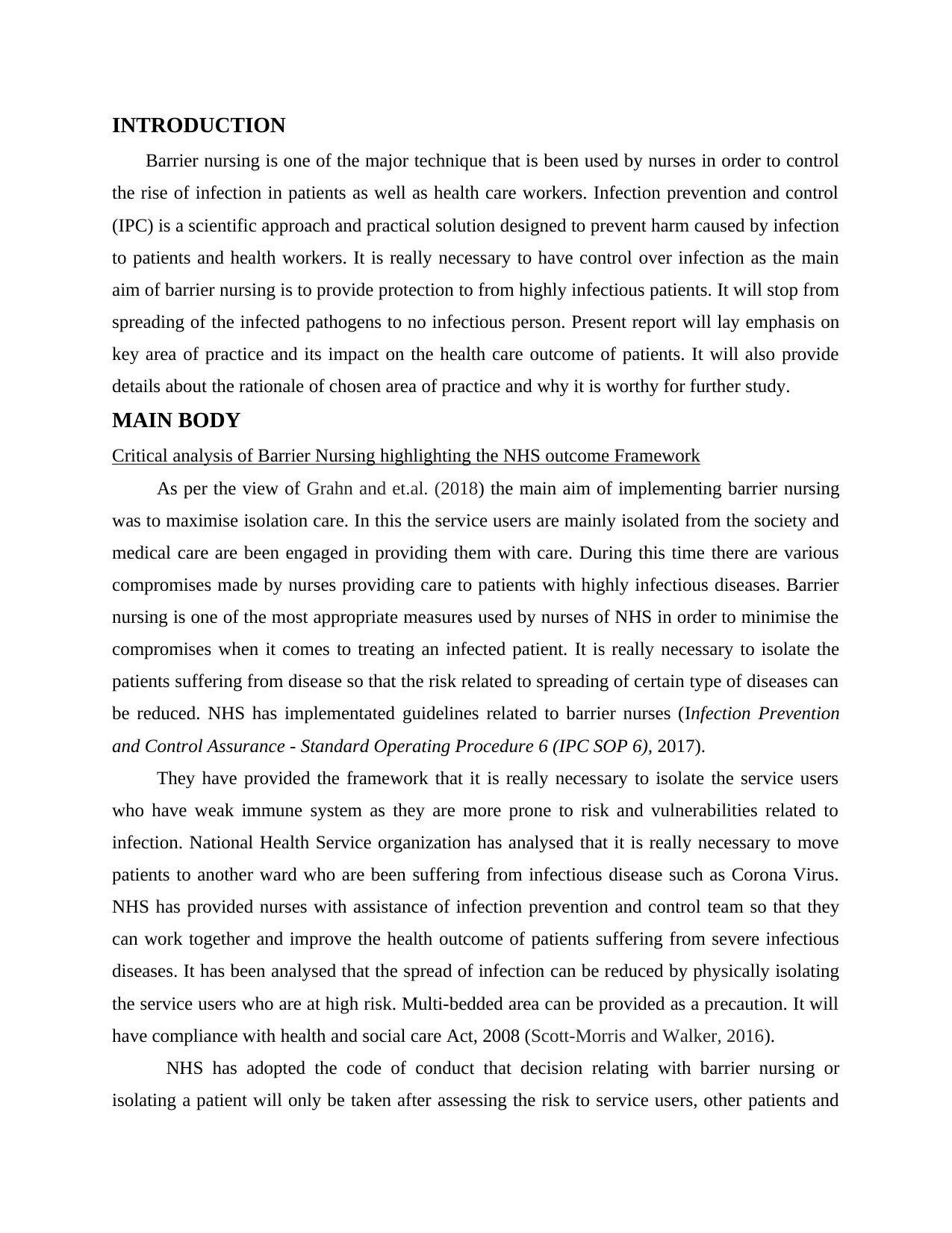
INTRODUCTION
Barrier nursing is one of the major technique that is been used by nurses in order to control
the rise of infection in patients as well as health care workers. Infection prevention and control
(IPC) is a scientific approach and practical solution designed to prevent harm caused by infection
to patients and health workers. It is really necessary to have control over infection as the main
aim of barrier nursing is to provide protection to from highly infectious patients. It will stop from
spreading of the infected pathogens to no infectious person. Present report will lay emphasis on
key area of practice and its impact on the health care outcome of patients. It will also provide
details about the rationale of chosen area of practice and why it is worthy for further study.
MAIN BODY
Critical analysis of Barrier Nursing highlighting the NHS outcome Framework
As per the view of Grahn and et.al. (2018) the main aim of implementing barrier nursing
was to maximise isolation care. In this the service users are mainly isolated from the society and
medical care are been engaged in providing them with care. During this time there are various
compromises made by nurses providing care to patients with highly infectious diseases. Barrier
nursing is one of the most appropriate measures used by nurses of NHS in order to minimise the
compromises when it comes to treating an infected patient. It is really necessary to isolate the
patients suffering from disease so that the risk related to spreading of certain type of diseases can
be reduced. NHS has implementated guidelines related to barrier nurses (Infection Prevention
and Control Assurance - Standard Operating Procedure 6 (IPC SOP 6), 2017).
They have provided the framework that it is really necessary to isolate the service users
who have weak immune system as they are more prone to risk and vulnerabilities related to
infection. National Health Service organization has analysed that it is really necessary to move
patients to another ward who are been suffering from infectious disease such as Corona Virus.
NHS has provided nurses with assistance of infection prevention and control team so that they
can work together and improve the health outcome of patients suffering from severe infectious
diseases. It has been analysed that the spread of infection can be reduced by physically isolating
the service users who are at high risk. Multi-bedded area can be provided as a precaution. It will
have compliance with health and social care Act, 2008 (Scott-Morris and Walker, 2016).
NHS has adopted the code of conduct that decision relating with barrier nursing or
isolating a patient will only be taken after assessing the risk to service users, other patients and
Barrier nursing is one of the major technique that is been used by nurses in order to control
the rise of infection in patients as well as health care workers. Infection prevention and control
(IPC) is a scientific approach and practical solution designed to prevent harm caused by infection
to patients and health workers. It is really necessary to have control over infection as the main
aim of barrier nursing is to provide protection to from highly infectious patients. It will stop from
spreading of the infected pathogens to no infectious person. Present report will lay emphasis on
key area of practice and its impact on the health care outcome of patients. It will also provide
details about the rationale of chosen area of practice and why it is worthy for further study.
MAIN BODY
Critical analysis of Barrier Nursing highlighting the NHS outcome Framework
As per the view of Grahn and et.al. (2018) the main aim of implementing barrier nursing
was to maximise isolation care. In this the service users are mainly isolated from the society and
medical care are been engaged in providing them with care. During this time there are various
compromises made by nurses providing care to patients with highly infectious diseases. Barrier
nursing is one of the most appropriate measures used by nurses of NHS in order to minimise the
compromises when it comes to treating an infected patient. It is really necessary to isolate the
patients suffering from disease so that the risk related to spreading of certain type of diseases can
be reduced. NHS has implementated guidelines related to barrier nurses (Infection Prevention
and Control Assurance - Standard Operating Procedure 6 (IPC SOP 6), 2017).
They have provided the framework that it is really necessary to isolate the service users
who have weak immune system as they are more prone to risk and vulnerabilities related to
infection. National Health Service organization has analysed that it is really necessary to move
patients to another ward who are been suffering from infectious disease such as Corona Virus.
NHS has provided nurses with assistance of infection prevention and control team so that they
can work together and improve the health outcome of patients suffering from severe infectious
diseases. It has been analysed that the spread of infection can be reduced by physically isolating
the service users who are at high risk. Multi-bedded area can be provided as a precaution. It will
have compliance with health and social care Act, 2008 (Scott-Morris and Walker, 2016).
NHS has adopted the code of conduct that decision relating with barrier nursing or
isolating a patient will only be taken after assessing the risk to service users, other patients and
⊘ This is a preview!⊘
Do you want full access?
Subscribe today to unlock all pages.

Trusted by 1+ million students worldwide
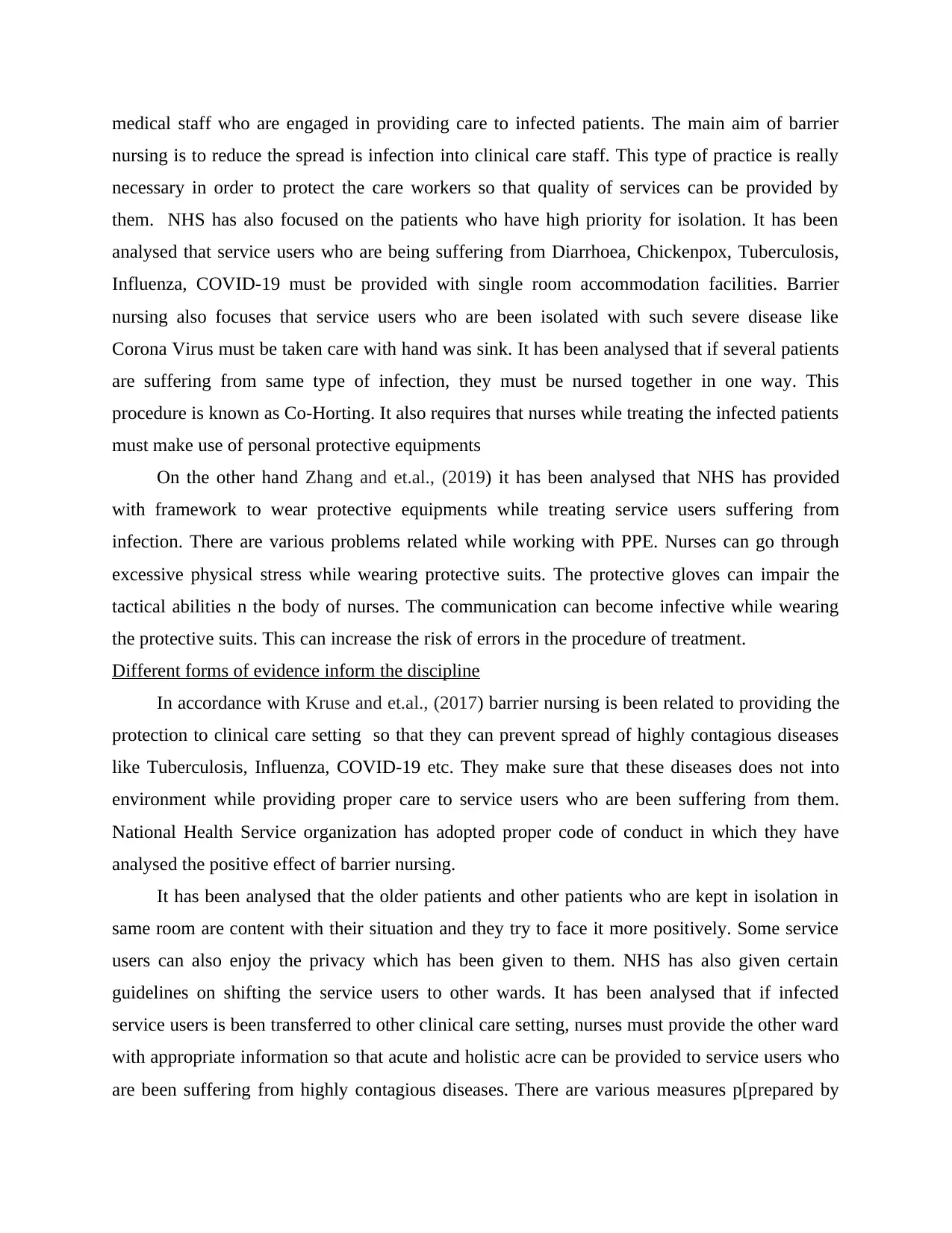
medical staff who are engaged in providing care to infected patients. The main aim of barrier
nursing is to reduce the spread is infection into clinical care staff. This type of practice is really
necessary in order to protect the care workers so that quality of services can be provided by
them. NHS has also focused on the patients who have high priority for isolation. It has been
analysed that service users who are being suffering from Diarrhoea, Chickenpox, Tuberculosis,
Influenza, COVID-19 must be provided with single room accommodation facilities. Barrier
nursing also focuses that service users who are been isolated with such severe disease like
Corona Virus must be taken care with hand was sink. It has been analysed that if several patients
are suffering from same type of infection, they must be nursed together in one way. This
procedure is known as Co-Horting. It also requires that nurses while treating the infected patients
must make use of personal protective equipments
On the other hand Zhang and et.al., (2019) it has been analysed that NHS has provided
with framework to wear protective equipments while treating service users suffering from
infection. There are various problems related while working with PPE. Nurses can go through
excessive physical stress while wearing protective suits. The protective gloves can impair the
tactical abilities n the body of nurses. The communication can become infective while wearing
the protective suits. This can increase the risk of errors in the procedure of treatment.
Different forms of evidence inform the discipline
In accordance with Kruse and et.al., (2017) barrier nursing is been related to providing the
protection to clinical care setting so that they can prevent spread of highly contagious diseases
like Tuberculosis, Influenza, COVID-19 etc. They make sure that these diseases does not into
environment while providing proper care to service users who are been suffering from them.
National Health Service organization has adopted proper code of conduct in which they have
analysed the positive effect of barrier nursing.
It has been analysed that the older patients and other patients who are kept in isolation in
same room are content with their situation and they try to face it more positively. Some service
users can also enjoy the privacy which has been given to them. NHS has also given certain
guidelines on shifting the service users to other wards. It has been analysed that if infected
service users is been transferred to other clinical care setting, nurses must provide the other ward
with appropriate information so that acute and holistic acre can be provided to service users who
are been suffering from highly contagious diseases. There are various measures p[prepared by
nursing is to reduce the spread is infection into clinical care staff. This type of practice is really
necessary in order to protect the care workers so that quality of services can be provided by
them. NHS has also focused on the patients who have high priority for isolation. It has been
analysed that service users who are being suffering from Diarrhoea, Chickenpox, Tuberculosis,
Influenza, COVID-19 must be provided with single room accommodation facilities. Barrier
nursing also focuses that service users who are been isolated with such severe disease like
Corona Virus must be taken care with hand was sink. It has been analysed that if several patients
are suffering from same type of infection, they must be nursed together in one way. This
procedure is known as Co-Horting. It also requires that nurses while treating the infected patients
must make use of personal protective equipments
On the other hand Zhang and et.al., (2019) it has been analysed that NHS has provided
with framework to wear protective equipments while treating service users suffering from
infection. There are various problems related while working with PPE. Nurses can go through
excessive physical stress while wearing protective suits. The protective gloves can impair the
tactical abilities n the body of nurses. The communication can become infective while wearing
the protective suits. This can increase the risk of errors in the procedure of treatment.
Different forms of evidence inform the discipline
In accordance with Kruse and et.al., (2017) barrier nursing is been related to providing the
protection to clinical care setting so that they can prevent spread of highly contagious diseases
like Tuberculosis, Influenza, COVID-19 etc. They make sure that these diseases does not into
environment while providing proper care to service users who are been suffering from them.
National Health Service organization has adopted proper code of conduct in which they have
analysed the positive effect of barrier nursing.
It has been analysed that the older patients and other patients who are kept in isolation in
same room are content with their situation and they try to face it more positively. Some service
users can also enjoy the privacy which has been given to them. NHS has also given certain
guidelines on shifting the service users to other wards. It has been analysed that if infected
service users is been transferred to other clinical care setting, nurses must provide the other ward
with appropriate information so that acute and holistic acre can be provided to service users who
are been suffering from highly contagious diseases. There are various measures p[prepared by
Paraphrase This Document
Need a fresh take? Get an instant paraphrase of this document with our AI Paraphraser
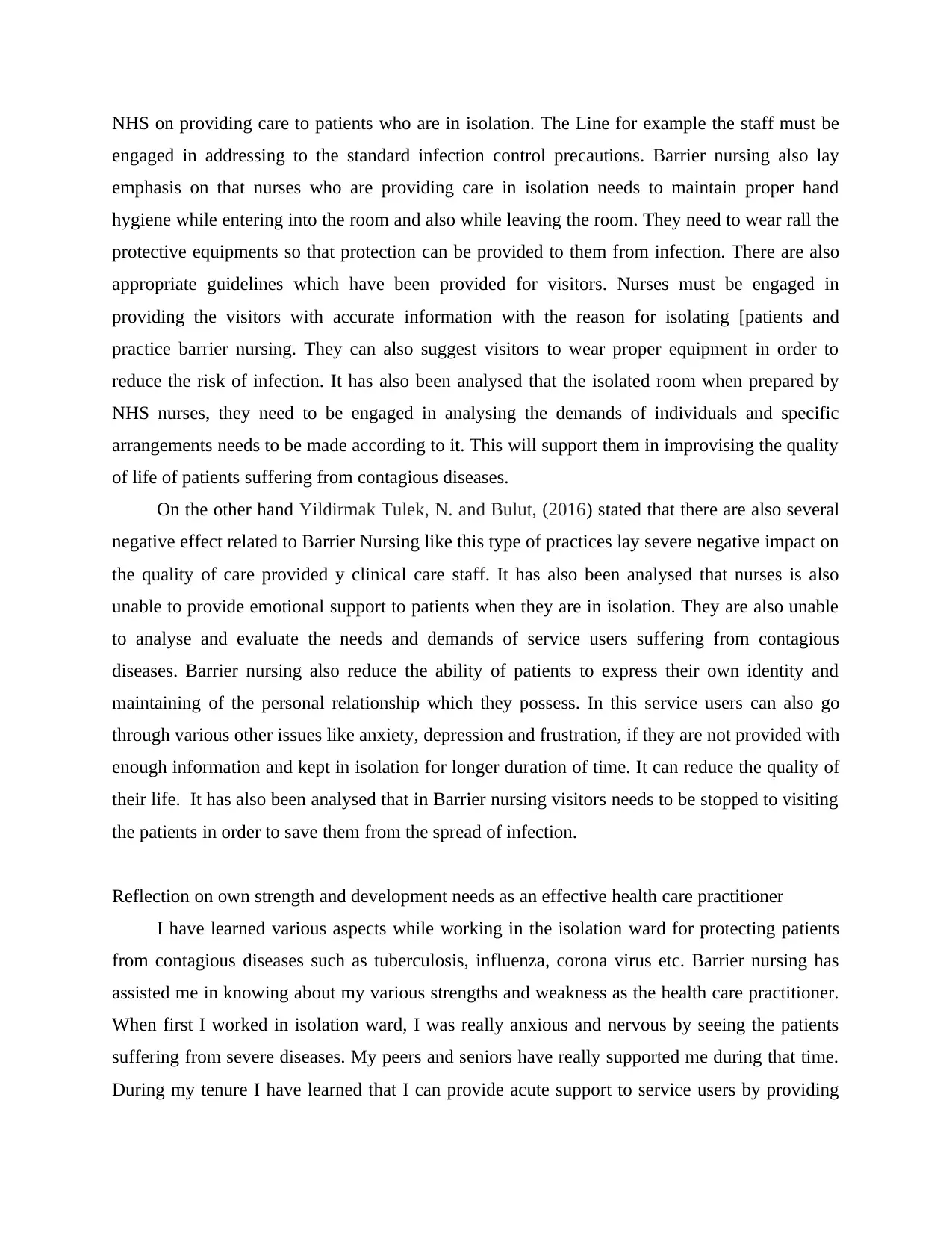
NHS on providing care to patients who are in isolation. The Line for example the staff must be
engaged in addressing to the standard infection control precautions. Barrier nursing also lay
emphasis on that nurses who are providing care in isolation needs to maintain proper hand
hygiene while entering into the room and also while leaving the room. They need to wear rall the
protective equipments so that protection can be provided to them from infection. There are also
appropriate guidelines which have been provided for visitors. Nurses must be engaged in
providing the visitors with accurate information with the reason for isolating [patients and
practice barrier nursing. They can also suggest visitors to wear proper equipment in order to
reduce the risk of infection. It has also been analysed that the isolated room when prepared by
NHS nurses, they need to be engaged in analysing the demands of individuals and specific
arrangements needs to be made according to it. This will support them in improvising the quality
of life of patients suffering from contagious diseases.
On the other hand Yildirmak Tulek, N. and Bulut, (2016) stated that there are also several
negative effect related to Barrier Nursing like this type of practices lay severe negative impact on
the quality of care provided y clinical care staff. It has also been analysed that nurses is also
unable to provide emotional support to patients when they are in isolation. They are also unable
to analyse and evaluate the needs and demands of service users suffering from contagious
diseases. Barrier nursing also reduce the ability of patients to express their own identity and
maintaining of the personal relationship which they possess. In this service users can also go
through various other issues like anxiety, depression and frustration, if they are not provided with
enough information and kept in isolation for longer duration of time. It can reduce the quality of
their life. It has also been analysed that in Barrier nursing visitors needs to be stopped to visiting
the patients in order to save them from the spread of infection.
Reflection on own strength and development needs as an effective health care practitioner
I have learned various aspects while working in the isolation ward for protecting patients
from contagious diseases such as tuberculosis, influenza, corona virus etc. Barrier nursing has
assisted me in knowing about my various strengths and weakness as the health care practitioner.
When first I worked in isolation ward, I was really anxious and nervous by seeing the patients
suffering from severe diseases. My peers and seniors have really supported me during that time.
During my tenure I have learned that I can provide acute support to service users by providing
engaged in addressing to the standard infection control precautions. Barrier nursing also lay
emphasis on that nurses who are providing care in isolation needs to maintain proper hand
hygiene while entering into the room and also while leaving the room. They need to wear rall the
protective equipments so that protection can be provided to them from infection. There are also
appropriate guidelines which have been provided for visitors. Nurses must be engaged in
providing the visitors with accurate information with the reason for isolating [patients and
practice barrier nursing. They can also suggest visitors to wear proper equipment in order to
reduce the risk of infection. It has also been analysed that the isolated room when prepared by
NHS nurses, they need to be engaged in analysing the demands of individuals and specific
arrangements needs to be made according to it. This will support them in improvising the quality
of life of patients suffering from contagious diseases.
On the other hand Yildirmak Tulek, N. and Bulut, (2016) stated that there are also several
negative effect related to Barrier Nursing like this type of practices lay severe negative impact on
the quality of care provided y clinical care staff. It has also been analysed that nurses is also
unable to provide emotional support to patients when they are in isolation. They are also unable
to analyse and evaluate the needs and demands of service users suffering from contagious
diseases. Barrier nursing also reduce the ability of patients to express their own identity and
maintaining of the personal relationship which they possess. In this service users can also go
through various other issues like anxiety, depression and frustration, if they are not provided with
enough information and kept in isolation for longer duration of time. It can reduce the quality of
their life. It has also been analysed that in Barrier nursing visitors needs to be stopped to visiting
the patients in order to save them from the spread of infection.
Reflection on own strength and development needs as an effective health care practitioner
I have learned various aspects while working in the isolation ward for protecting patients
from contagious diseases such as tuberculosis, influenza, corona virus etc. Barrier nursing has
assisted me in knowing about my various strengths and weakness as the health care practitioner.
When first I worked in isolation ward, I was really anxious and nervous by seeing the patients
suffering from severe diseases. My peers and seniors have really supported me during that time.
During my tenure I have learned that I can provide acute support to service users by providing
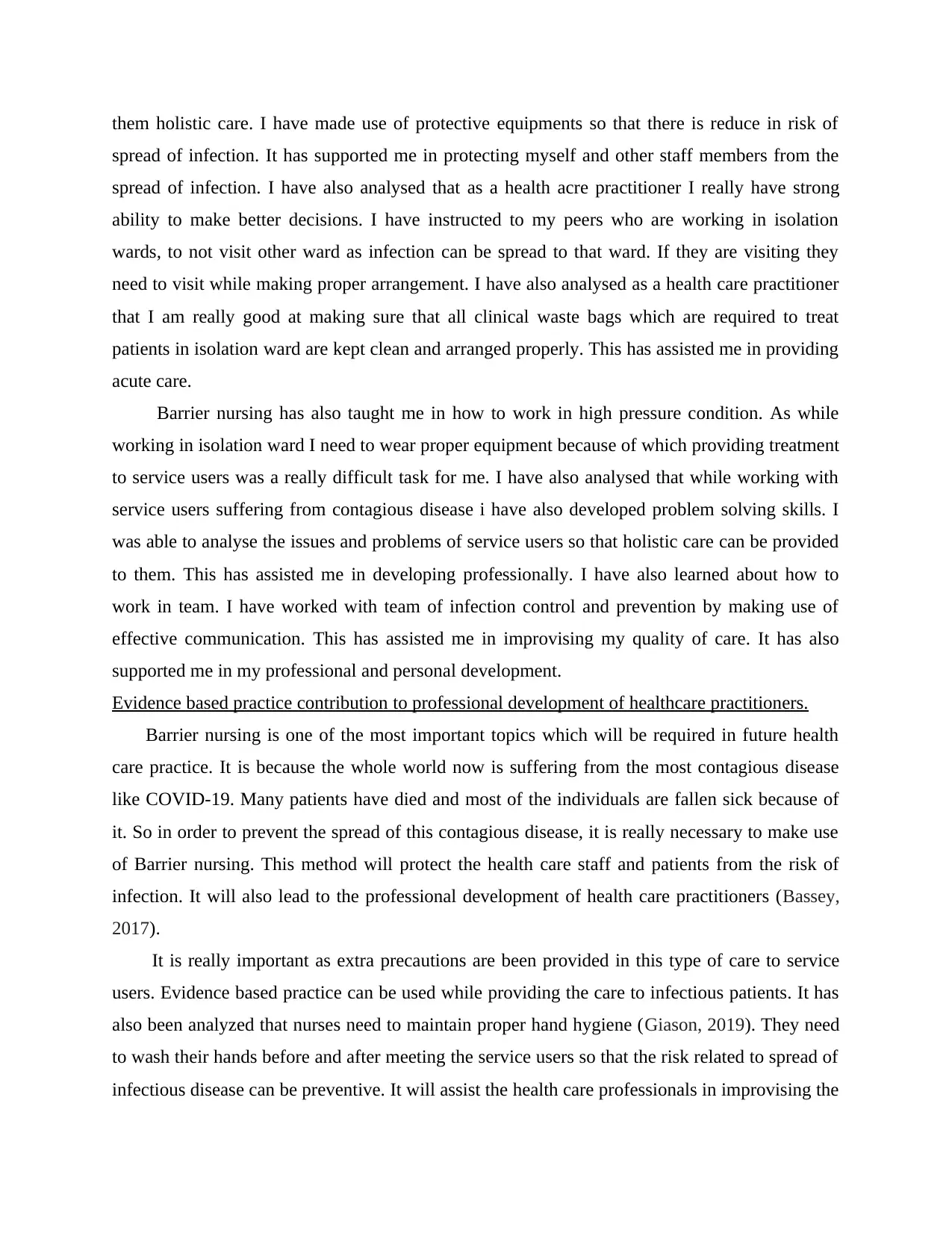
them holistic care. I have made use of protective equipments so that there is reduce in risk of
spread of infection. It has supported me in protecting myself and other staff members from the
spread of infection. I have also analysed that as a health acre practitioner I really have strong
ability to make better decisions. I have instructed to my peers who are working in isolation
wards, to not visit other ward as infection can be spread to that ward. If they are visiting they
need to visit while making proper arrangement. I have also analysed as a health care practitioner
that I am really good at making sure that all clinical waste bags which are required to treat
patients in isolation ward are kept clean and arranged properly. This has assisted me in providing
acute care.
Barrier nursing has also taught me in how to work in high pressure condition. As while
working in isolation ward I need to wear proper equipment because of which providing treatment
to service users was a really difficult task for me. I have also analysed that while working with
service users suffering from contagious disease i have also developed problem solving skills. I
was able to analyse the issues and problems of service users so that holistic care can be provided
to them. This has assisted me in developing professionally. I have also learned about how to
work in team. I have worked with team of infection control and prevention by making use of
effective communication. This has assisted me in improvising my quality of care. It has also
supported me in my professional and personal development.
Evidence based practice contribution to professional development of healthcare practitioners.
Barrier nursing is one of the most important topics which will be required in future health
care practice. It is because the whole world now is suffering from the most contagious disease
like COVID-19. Many patients have died and most of the individuals are fallen sick because of
it. So in order to prevent the spread of this contagious disease, it is really necessary to make use
of Barrier nursing. This method will protect the health care staff and patients from the risk of
infection. It will also lead to the professional development of health care practitioners (Bassey,
2017).
It is really important as extra precautions are been provided in this type of care to service
users. Evidence based practice can be used while providing the care to infectious patients. It has
also been analyzed that nurses need to maintain proper hand hygiene (Giason, 2019). They need
to wash their hands before and after meeting the service users so that the risk related to spread of
infectious disease can be preventive. It will assist the health care professionals in improvising the
spread of infection. It has supported me in protecting myself and other staff members from the
spread of infection. I have also analysed that as a health acre practitioner I really have strong
ability to make better decisions. I have instructed to my peers who are working in isolation
wards, to not visit other ward as infection can be spread to that ward. If they are visiting they
need to visit while making proper arrangement. I have also analysed as a health care practitioner
that I am really good at making sure that all clinical waste bags which are required to treat
patients in isolation ward are kept clean and arranged properly. This has assisted me in providing
acute care.
Barrier nursing has also taught me in how to work in high pressure condition. As while
working in isolation ward I need to wear proper equipment because of which providing treatment
to service users was a really difficult task for me. I have also analysed that while working with
service users suffering from contagious disease i have also developed problem solving skills. I
was able to analyse the issues and problems of service users so that holistic care can be provided
to them. This has assisted me in developing professionally. I have also learned about how to
work in team. I have worked with team of infection control and prevention by making use of
effective communication. This has assisted me in improvising my quality of care. It has also
supported me in my professional and personal development.
Evidence based practice contribution to professional development of healthcare practitioners.
Barrier nursing is one of the most important topics which will be required in future health
care practice. It is because the whole world now is suffering from the most contagious disease
like COVID-19. Many patients have died and most of the individuals are fallen sick because of
it. So in order to prevent the spread of this contagious disease, it is really necessary to make use
of Barrier nursing. This method will protect the health care staff and patients from the risk of
infection. It will also lead to the professional development of health care practitioners (Bassey,
2017).
It is really important as extra precautions are been provided in this type of care to service
users. Evidence based practice can be used while providing the care to infectious patients. It has
also been analyzed that nurses need to maintain proper hand hygiene (Giason, 2019). They need
to wash their hands before and after meeting the service users so that the risk related to spread of
infectious disease can be preventive. It will assist the health care professionals in improvising the
⊘ This is a preview!⊘
Do you want full access?
Subscribe today to unlock all pages.

Trusted by 1+ million students worldwide
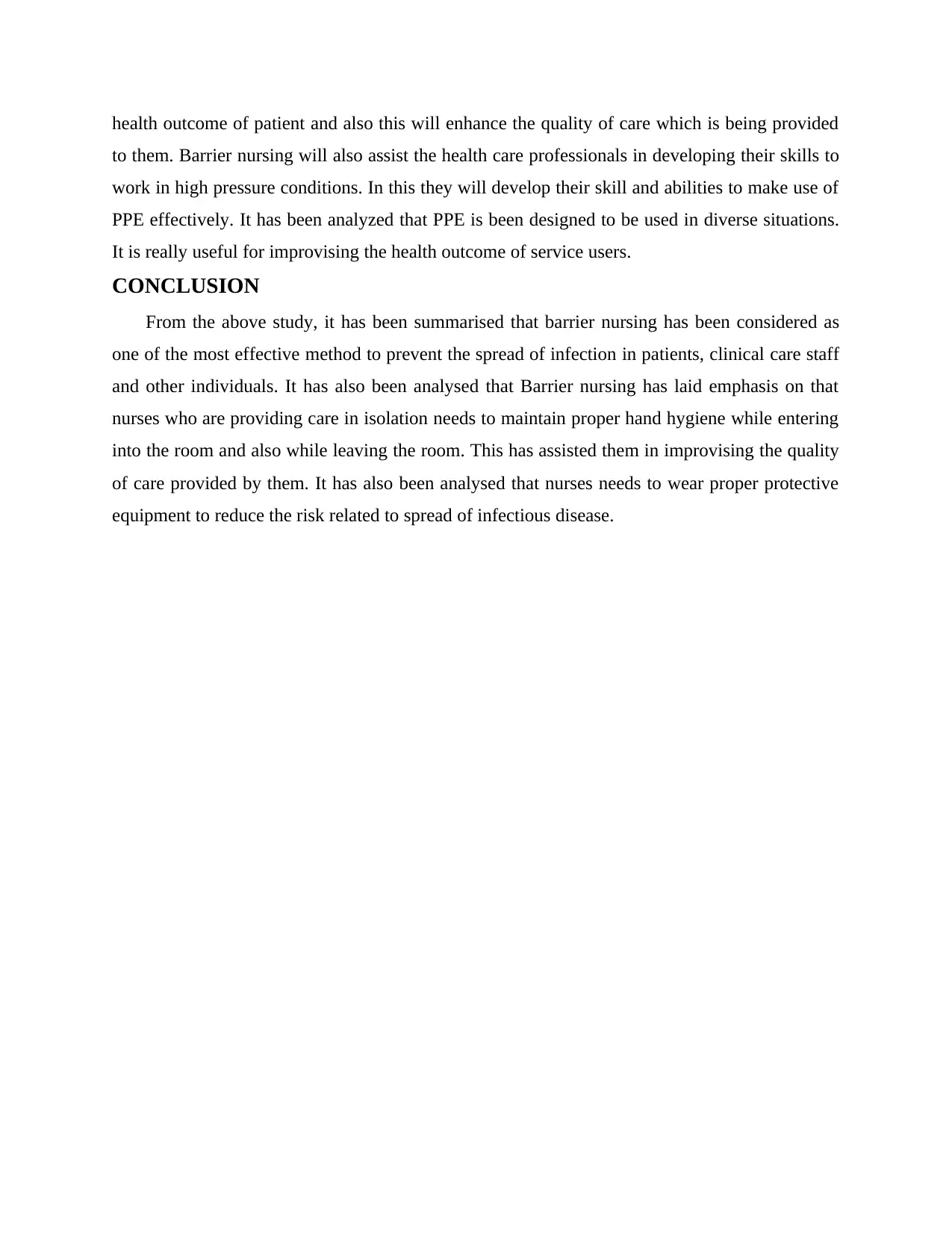
health outcome of patient and also this will enhance the quality of care which is being provided
to them. Barrier nursing will also assist the health care professionals in developing their skills to
work in high pressure conditions. In this they will develop their skill and abilities to make use of
PPE effectively. It has been analyzed that PPE is been designed to be used in diverse situations.
It is really useful for improvising the health outcome of service users.
CONCLUSION
From the above study, it has been summarised that barrier nursing has been considered as
one of the most effective method to prevent the spread of infection in patients, clinical care staff
and other individuals. It has also been analysed that Barrier nursing has laid emphasis on that
nurses who are providing care in isolation needs to maintain proper hand hygiene while entering
into the room and also while leaving the room. This has assisted them in improvising the quality
of care provided by them. It has also been analysed that nurses needs to wear proper protective
equipment to reduce the risk related to spread of infectious disease.
to them. Barrier nursing will also assist the health care professionals in developing their skills to
work in high pressure conditions. In this they will develop their skill and abilities to make use of
PPE effectively. It has been analyzed that PPE is been designed to be used in diverse situations.
It is really useful for improvising the health outcome of service users.
CONCLUSION
From the above study, it has been summarised that barrier nursing has been considered as
one of the most effective method to prevent the spread of infection in patients, clinical care staff
and other individuals. It has also been analysed that Barrier nursing has laid emphasis on that
nurses who are providing care in isolation needs to maintain proper hand hygiene while entering
into the room and also while leaving the room. This has assisted them in improvising the quality
of care provided by them. It has also been analysed that nurses needs to wear proper protective
equipment to reduce the risk related to spread of infectious disease.
Paraphrase This Document
Need a fresh take? Get an instant paraphrase of this document with our AI Paraphraser
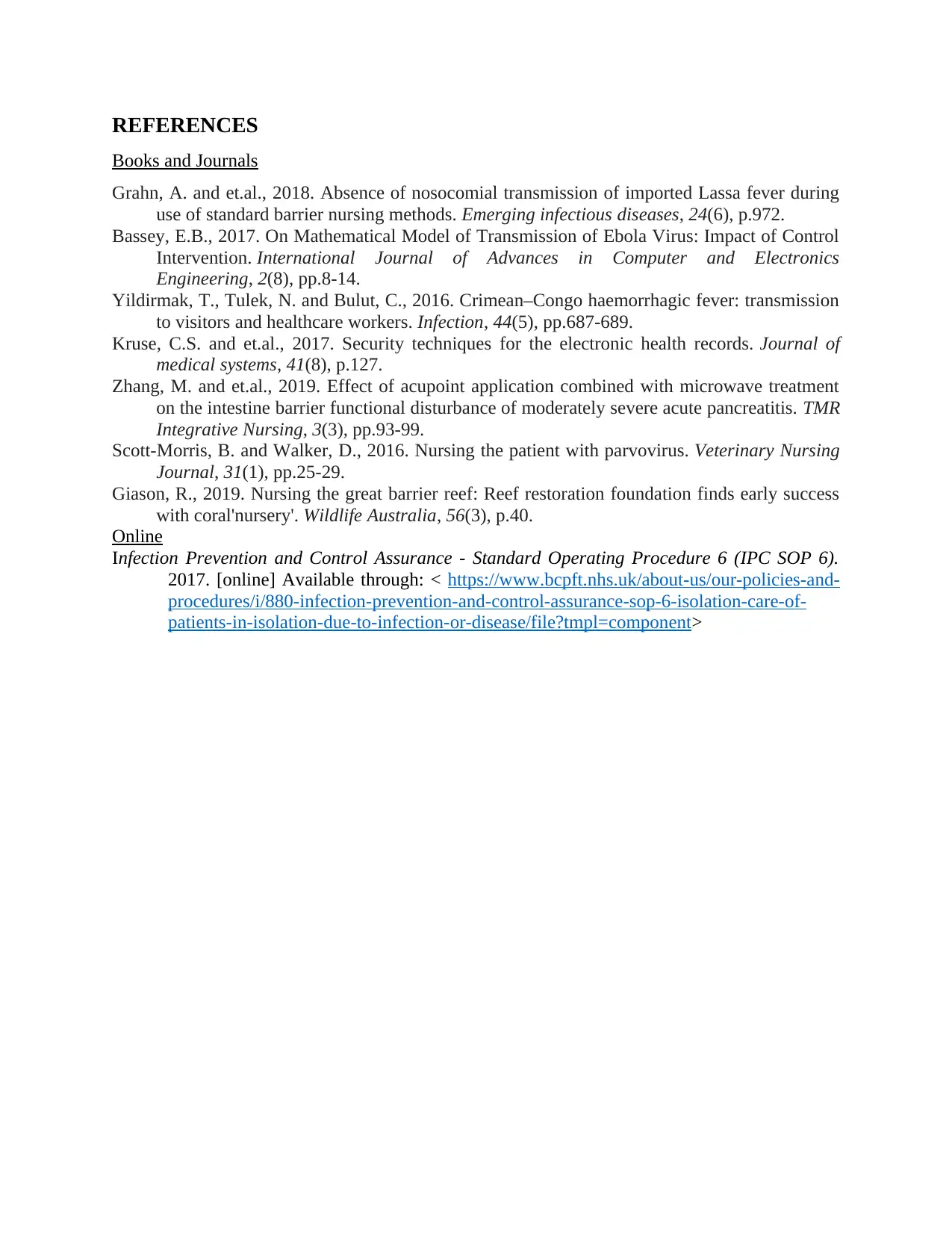
REFERENCES
Books and Journals
Grahn, A. and et.al., 2018. Absence of nosocomial transmission of imported Lassa fever during
use of standard barrier nursing methods. Emerging infectious diseases, 24(6), p.972.
Bassey, E.B., 2017. On Mathematical Model of Transmission of Ebola Virus: Impact of Control
Intervention. International Journal of Advances in Computer and Electronics
Engineering, 2(8), pp.8-14.
Yildirmak, T., Tulek, N. and Bulut, C., 2016. Crimean–Congo haemorrhagic fever: transmission
to visitors and healthcare workers. Infection, 44(5), pp.687-689.
Kruse, C.S. and et.al., 2017. Security techniques for the electronic health records. Journal of
medical systems, 41(8), p.127.
Zhang, M. and et.al., 2019. Effect of acupoint application combined with microwave treatment
on the intestine barrier functional disturbance of moderately severe acute pancreatitis. TMR
Integrative Nursing, 3(3), pp.93-99.
Scott-Morris, B. and Walker, D., 2016. Nursing the patient with parvovirus. Veterinary Nursing
Journal, 31(1), pp.25-29.
Giason, R., 2019. Nursing the great barrier reef: Reef restoration foundation finds early success
with coral'nursery'. Wildlife Australia, 56(3), p.40.
Online
Infection Prevention and Control Assurance - Standard Operating Procedure 6 (IPC SOP 6).
2017. [online] Available through: < https://www.bcpft.nhs.uk/about-us/our-policies-and-
procedures/i/880-infection-prevention-and-control-assurance-sop-6-isolation-care-of-
patients-in-isolation-due-to-infection-or-disease/file?tmpl=component>
Books and Journals
Grahn, A. and et.al., 2018. Absence of nosocomial transmission of imported Lassa fever during
use of standard barrier nursing methods. Emerging infectious diseases, 24(6), p.972.
Bassey, E.B., 2017. On Mathematical Model of Transmission of Ebola Virus: Impact of Control
Intervention. International Journal of Advances in Computer and Electronics
Engineering, 2(8), pp.8-14.
Yildirmak, T., Tulek, N. and Bulut, C., 2016. Crimean–Congo haemorrhagic fever: transmission
to visitors and healthcare workers. Infection, 44(5), pp.687-689.
Kruse, C.S. and et.al., 2017. Security techniques for the electronic health records. Journal of
medical systems, 41(8), p.127.
Zhang, M. and et.al., 2019. Effect of acupoint application combined with microwave treatment
on the intestine barrier functional disturbance of moderately severe acute pancreatitis. TMR
Integrative Nursing, 3(3), pp.93-99.
Scott-Morris, B. and Walker, D., 2016. Nursing the patient with parvovirus. Veterinary Nursing
Journal, 31(1), pp.25-29.
Giason, R., 2019. Nursing the great barrier reef: Reef restoration foundation finds early success
with coral'nursery'. Wildlife Australia, 56(3), p.40.
Online
Infection Prevention and Control Assurance - Standard Operating Procedure 6 (IPC SOP 6).
2017. [online] Available through: < https://www.bcpft.nhs.uk/about-us/our-policies-and-
procedures/i/880-infection-prevention-and-control-assurance-sop-6-isolation-care-of-
patients-in-isolation-due-to-infection-or-disease/file?tmpl=component>
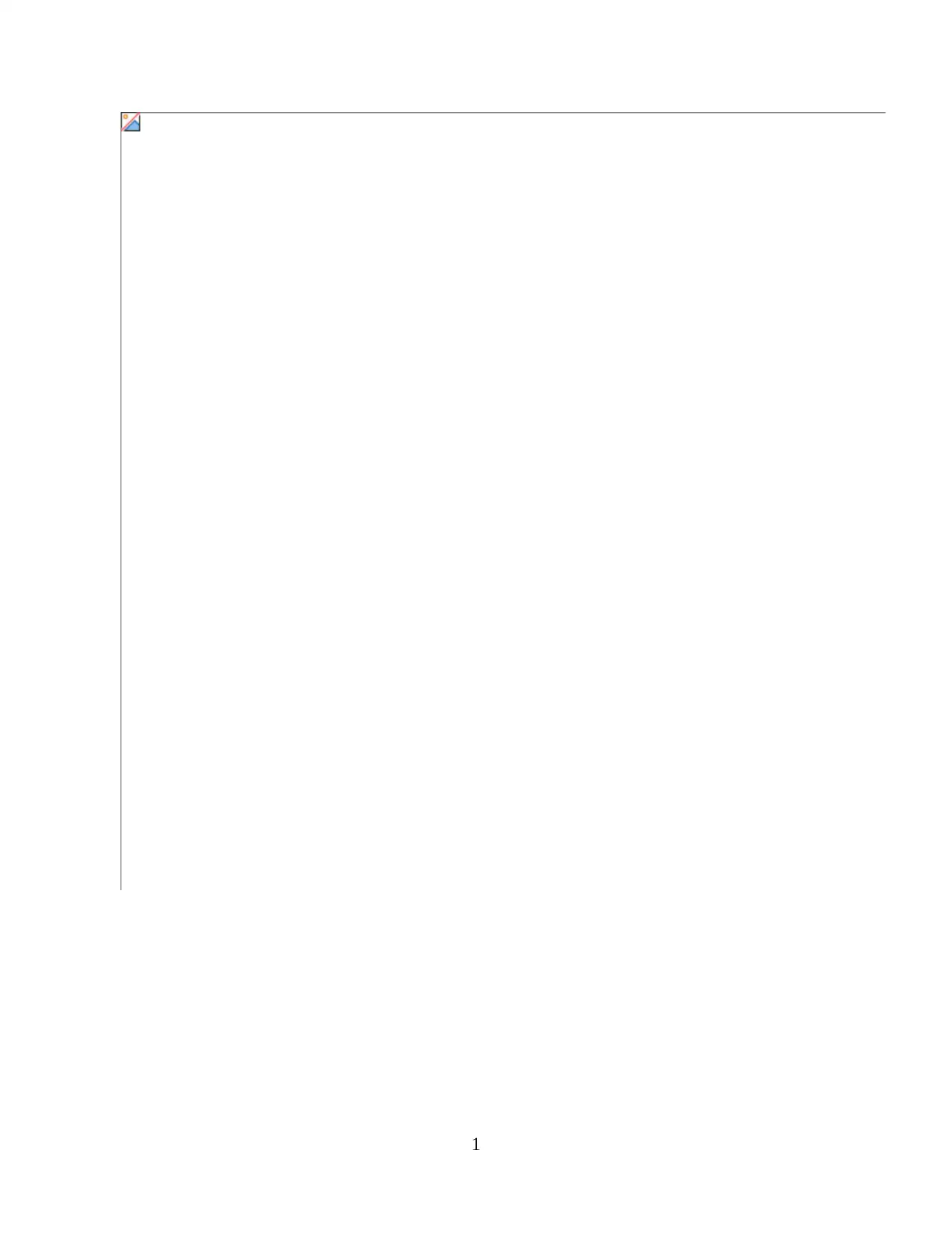
1
⊘ This is a preview!⊘
Do you want full access?
Subscribe today to unlock all pages.

Trusted by 1+ million students worldwide
1 out of 9
Related Documents
Your All-in-One AI-Powered Toolkit for Academic Success.
+13062052269
info@desklib.com
Available 24*7 on WhatsApp / Email
![[object Object]](/_next/static/media/star-bottom.7253800d.svg)
Unlock your academic potential
Copyright © 2020–2025 A2Z Services. All Rights Reserved. Developed and managed by ZUCOL.





